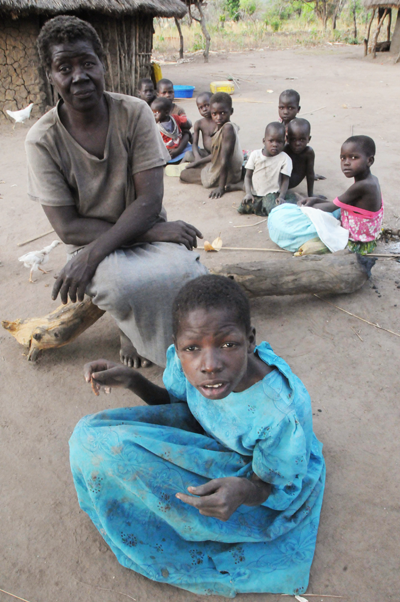The young teenage boy in the photo cannot stand on his own. He is being held up on his feet in front of a thatched roof hut in northern Uganda. His face is obscured for privacy, but it is obvious how the musculature of his legs has wasted away. He looks a bit like an old man.
Like thousands of other Ugandan children of the Acholi people, he is the victim of Nodding Syndrome, a mysterious epidemic named for its early symptom of a strange stereotypical nodding of the head, which has spread throughout northern Uganda in lockstep with a brutal armed insurgency.
Some have imagined a virus is at play, like measles. Others think there is some toxin in the food, air, or water. There appears to be a strong association to the parasitic worm that causes river blindness, which is transmitted to humans through fly bites. But none of these theories have yielded compelling proof.
Notice the obvious paradox
As rare and mysterious as it is, Nodding Syndrome might also be a clue to another human malady of more universal risk and concern. Thanks to the pioneering research of Ontario’s chief forensic pathologist Michael Pollanen, a man better known for his courtroom testimony on the physical trauma to Canadian murder victims, this mostly neglected tropical affliction is starting to cast light on the nature of age-related dementia and Alzheimer’s.
“Notice the obvious paradox. Teenagers. In an epidemic. In northern Uganda. Dying of a neurodegenerative disease,” Pollanen told a small audience at the University of Toronto’s Health Science’s Building. “It’s totally remarkable.”
He meant that they were dying of ailments that, everywhere else, are exclusive to old people. There are rare exceptions, as in inherited genetic diseases. But if that is what was happening here, a parent would be sick too. But adults do not get Nodding Syndrome.
“Why are the parents not affected?” Pollanen said. The answer, he believes, is some unexplained convergence of genetic and environmental factors. This is the third outbreak like this in Africa, after one in Tanzania in the 1960s and one in South Sudan in 1998.
Nodding Syndrome is a baffling epidemic, strangely oriented in space and time. It exists today only in the extremely impoverished and insecure environment of subsistence-farming villages and camps for internally displaced people in Uganda’s northern border regions near South Sudan. It affects only children between about five and 15, peaking around age 11.
Its onset coincided exactly with the societal turmoil unleashed over the 1990s and early 2000s when warlord Joseph Kony and his Lord’s Resistance Army ran rampage over this troubled part of central Africa, abducting children as sex slaves or soldiers, displacing millions, and committing crimes against humanity that led to Kony’s indictment in absentia by the International Criminal Court.

The epidemic was first discovered in 2003, at the height of the LRA insurgency, in a camp for internally displaced persons in Kitgum district. Children would first display the classical nodding, thought to be atonic seizures, or a generalized brief loss of muscle tone. From there, the disease’s progress is cruel and swift, through severe intellectual impairment to, in most cases, full blown grand mal seizures. It appears to be almost always fatal.
In the later stages, victims are mute, some are paralyzed. Some have symptoms more like Parkinsonism. Some have florid frontal lobe syndrome that causes strange behaviours like praying out loud incessantly or constant touching of genitalia, Pollanen said.
Secondary injuries multiply the disease’s toll in the perilous environment of camps for internally displaced persons. Victims are accidentally burned by charcoal cooking fires, drown in open water, injure themselves falling, or are the helpless targets of sexual violence, Pollanen said.
The first and best known theory was built on the strong epidemiological association with onchocerciasis, a common parasitic infection of a worm that can cause skin problems, blindness, and perhaps affect the brain somehow.
This theory had two versions. Either the worms were actually getting into the brain, or there was some indirect mechanism by which the human body engages in what Pollanen called “molecular mimicry” of a substance from the worm, creating something like an autoimmune disease.
Nodding Syndrome is a baffling epidemic, strangely oriented in space and time
Another theory was that Nodding Syndrome was the lingering effect of infection by the measles virus, leading to a neurodegenerative disease. Perhaps this epidemic was like the plot of the movie Awakenings, in which infection with an influenza virus led many years later to a disease known as post-encephalitic Parkinsonism.
Pollanen said the U.S. Centers for Disease Control, which has a keen eye on emerging diseases, investigated Nodding Syndrome and it is “apparent” to him that they did not find all that could be found in the dissected brains of the victims.
Pollanen has studied the brains of five fatal cases, all of whom died in 2014, including some of the same ones studied by CDC. One typical case, a 14-year-old girl, was said to be unkempt, malnourished, wasted, dehydrated, with multiple healing injuries, who eventually died of dehydration and malnutrition.
A key finding was no evidence of a worm infection, and no signs of viral infection.
The common factor, as Pollanen and colleagues describe in a new paper, is neurofibrillary tangles, the very same distinctive brain lesions that play the central role in Alzheimer’s.

He asked his audience of doctors and epidemiologists what it would look like if these tangles were in the frontal cortex, and the answer came back, “memory and cognitive impairments.” Likewise, what if they were in the brain stem? That would show as Parkinsonism. The symptoms reflect the distribution of tangles in the brain.
This is the scientific excitement, that Nodding Syndrome somehow “recapitulates” the events of Alzheimer’s, but in children.
Pollanen said there may be some clue here about the causal connection between age-related plaques in the brain’s grey matter and tangles in the neurons. He described the many questions that remain. It is not clear, for example, why children born later in the birth order are much less likely to be affected.
He plans to return to Uganda to investigate and observe later stage cases, ages 15 to 22, funded by the foundation of the late Raymond Chang, as the work is too speculative for traditional funding agencies.
• Email: jbrean@nationalpost.com | Twitter: josephbrean


